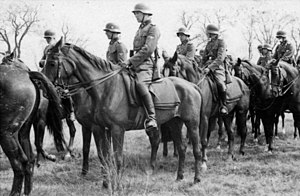SS Cavalry Brigade
| SS Cavalry brigade | |
|---|---|
 SS Cavalry Brigade of the Waffen-SS, 23 September 1941 USSR | |
| Active | 1940–1942 |
| Country | |
| Branch | |
| Type | Cavalry |
| Size | Brigade |
| Commanders | |
| Notable commanders | Hermann Fegelein |
The SS Cavalry Brigade (SS-Kavallerie-Brigade) was a unit of the German
Formation
The SS Cavalry Brigade was based on the SS Totenkopf Horse Regiment, which was raised in September 1939, for police and security duties in Poland, under the command of Hermann Fegelein.[1] By April 1940, it consisted of 8 Saber Squadrons, 9th Replacement, 10th Heavy and 11th Technical Squadrons and a 12th Horse Battery of four 80mm guns. In May it was divided into two regiments, SS Totenkopf Horse Regiments 1 & 2, each of four squadrons, 5th Heavy and 6th Horse Battery also included were Signals, Engineer and Motorcycle platoons.[1]
In March 1941 they were renamed SS Cavalry Regiments 1 and 2 and reformed again into 1st, 2nd and 3rd Saber Squadrons, 4th (
Soviet Union
After the German invasion of the
By 1 August, the SS Cavalry Regiment was responsible for the death of 800 people; five days later, on 6 August, this total had reached 3,000 "Jews and Partisans".
Throughout the next weeks, members of the SS Cavalry Regiment 1, under Lombard's command, murdered an estimated 11,000 Jews and more than 400 dispersed soldiers of the Red Army.[6] Sturmbannführer Franz Magill and his men of the SS Cavalry Regiment 2, assisted in the roundup of all the men aged 18 to 55 in the city of Pinsk, where 5,000 to 8,000 men were shot and shortly afterwards, another 2,000 residents including women, children and older men were murdered.[7] Fegelein's final report on the operation, dated 18 September 1941, states that they killed 14,178 Jews, 1,001 partisans, and 699 Red Army soldiers with losses of 17 dead, 36 wounded, and 3 missing.[8][9] The historian Henning Pieper estimates the actual number of Jews killed was closer to 23,700.[10]
General of Infantry Max von Schenckendorff, commander of Army Group Rear Area behind Army Group Centre described their operations the following way:
The SS Cavalry Brigade operates as follows: at dawn, without prior reconnaissance, the troop tasked with the inspection of a village rides into it at full speed and out the other end, occupies the outer edges of the village in a trice, in accordance with an agreed plan, and then gathers the whole population together, including women and children, for inspection. In many cases the skill and experience of the commanding officer, and also of the accompanying SD and GFP groups together with their interpreters, will decide upon the composition of the male inhabitants and their occupation, as well as upon their fate, so that the area is cleared of opposition and pacified.[11]
After the
In March 1942, the SS Cavalry Brigade was used as the
Post-war
This section needs expansion. You can help by adding to it. (January 2016) |
German authorities investigated the activities of the SS cavalry formations in the 1960s.[13]
Notes
- ^ a b c d Fowler, Jeffery; Chappell, Mike. Axis Cavalry in World War II. p. 20.
- ^ a b Miller 2006, p. 309.
- Browning, Cristopher; Jürgen Matthäus(2007). The Origins of the Final Solution: The Evolution of Nazi Jewish Policy, September 1939 – March 1942. p. 279.
- ^ Browning, Cristopher; Matthaus Jurgen. The Origins of the Final Solution. p. 280.
- ^ a b Browning, Cristopher; Matthaus Jurgen. The Origins of the Final Solution. p. 281.
- ^ Cuppers, Martin. Vorreiter der Shoah, Ein Vergleich der Einsätze der beiden SS-Kavallerieregimenter im August 1941. p. 279.
- ^ Cuppers, Martin. Vorreiter der Shoah. p. 282.
- ^ Pieper 2015, pp. 119–120.
- ^ Miller 2006, p. 310.
- ^ Pieper 2015, p. 120.
- ^ Case studies on Anti-Partisan Warfare during the Eastern Campaign" by Ruth Bettina Birn in "From Peace to War: Germany, Soviet Russia and the World, 1939-1941" edited by Bernd Wegner, p. 278.
- ^ Ripley, Tim. The Waffen-SS at War: Hitler's Praetorians 1925-1945. p. 78.
- ^ Parker 2014, p. 223.
References
- Browning, Christopher R.; Matthäus, Jürgen (2007). The Origins of the Final Solution: The Evolution of Nazi Jewish Policy, September 1939 – March 1942. Lincoln, Nebraska: University of Nebraska Press. ISBN 978-0-8032-5979-9.
- Cuppers, Martin (2006), Vorreiter der Shoah, Ein Vergleich der Einsätze der beiden SS-Kavallerieregimenter im August 1941, Meidenbauer Martin Verlag, ISBN 3-89975-080-2
- Fowler, Jeffrey T. (2001). Axis Cavalry in World War II. Oxford, UK: Osprey Publishing. ISBN 1-84176-323-3.
- Miller, Michael (2006). Leaders of the SS and German Police, Vol. 1. San Jose, California: R. James Bender. ISBN 978-93-297-0037-2.
- Parker, Danny S. (2014). Hitler's Warrior: The Life and Wars of SS Colonel Jochen Peiper. Boston: Da Capo Press. ISBN 978-0-306-82154-7.
- Pieper, Henning (2015). Fegelein's Horsemen and Genocidal Warfare: The SS Cavalry Brigade in the Soviet Union. Houndmills, UK: Palgrave Macmillan. ISBN 978-1-137-45631-1.
- Ripley, Tim (2004). The Waffen-SS at War: Hitler's Praetorians, 1925–1945. St. Paul, Minnesota: Zenith Press. ISBN 0-7603-2068-3.
